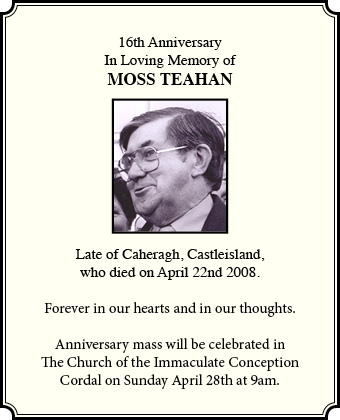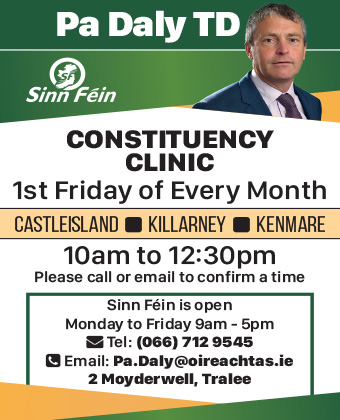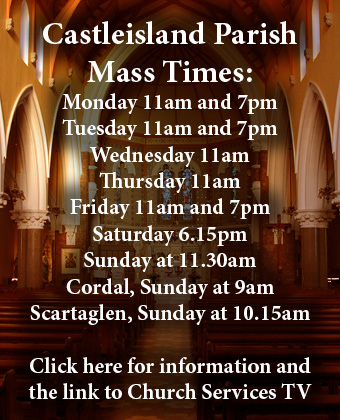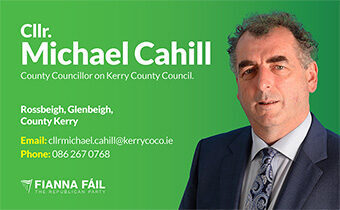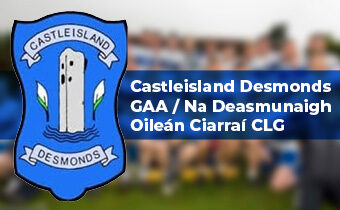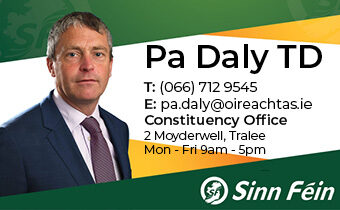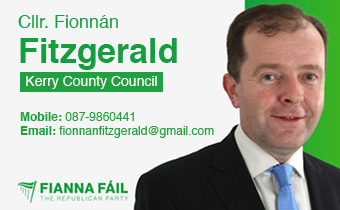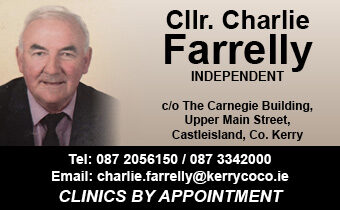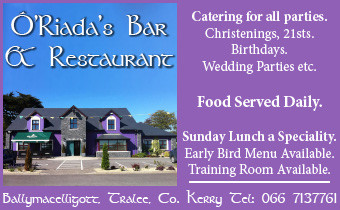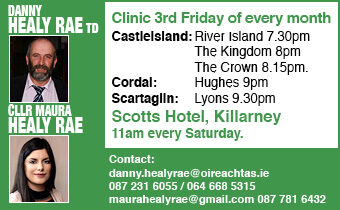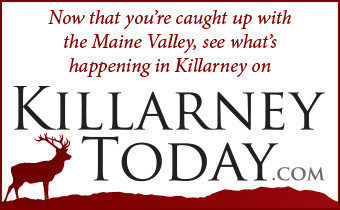

A fine gathering, for the times we’re living in, as close to 40 people assembled at a beautiful, if lonesome spot on the side of a hill in Glountane in Cordal at around 8pm on Wednesday evening.
The beauty of the location is immediately obvious to all, the loneliness dawns with the revelation that here, a century ago, an accidental explosion killed IRA Volunteer and Currow native Tom Fleming and wounded several others on the afternoon of Thursday, June 16-1921.
June 16th also marked the anniversary of the unveiling of the monument to Volunteer Fleming in 1950 at which this week’s gathering took place.
A Link With 1950 Unveiling
Wreaths have been laid at the monument most years since on this anniversary and Wednesday evening’s ceremony had a personal link to the 1950 unveiling in that Rosarie Cournane – nee Fleming, a grand-niece of Tom Fleming, attended that event as a very young child.
A severe form of restriction was imposed on this week’s ceremony by an army of savage midges and speeches and the overall run of the event had to be cut to the minimum.
A Tricolor and a Signpost
The attendees all parked their cars on the road down from the site of the monument – alerted by a tricolor and a handmade signpost pointing to the destination and informing us that it was 200 yards up the narrow road.
A fine specimen of a local fox stood bolt upright covering a third of the width of the road before Noel O’Mahony with his pipes in full tune struck up and led the gathered up the hill and on their mission.
Belief to An Absolute Degree
Local man Patrick O’Leary had the monument in perfect order as his co-organiser, Eamonn Ó Braoin spoke briefly about Tom Fleming, the times he lived in and the sacrifice he made for the cause he and so many of his countrymen and women believed in to an absolute degree.
Eamonn then introduced North Kerry historian, Martin Moore who was also forced to curtail his talk but he managed to provide the gathering with an insight into the terrible times our people of a century ago lived through.
Final Heroic Act
Mr. Moore also told of Tom Fleming’s final heroic act as he realised the improvised device was about to explode. He threw himself across it and certainly ensured that there were no other fatalities from the unfortunate accident.
Rosarie Cournane was invited to perform the wreath laying part of the ceremony and she was assisted by Patrick O’Leary and a decade of the rosary was said as Gaeilge.
What Would He Think of Ireland Today
On behalf of the Fleming family and relations, Eamon Fleming thanked all who organised and attended the event and he asked, thought provokingly, what his grand-uncle would think of the Ireland he died for and more over the Ireland of today ?
The playing of Amhrán na bhFiann by Noel O’Mahony was followed by a rapid dispersal to the safety and shelter of vehicles waiting down the road.
Aircraft Overhead – Then and Now
You’ll see in the following account by Captain Peter Browne that an aeroplane flew over the site of the explosion just before it happened on that fateful day in 1921.
Oddly, an aircraft flew over the site of the monument during Wednesday evening’s ceremony just before the laying of the wreath and was remarked on by Eamonn Ó Braoin.
Bureau of Military History Account
In a vivid account in the Bureau of Military History 1913-1921, Captain Peter Browne of the Scartaglin Company Irish Volunteers tells the story of that fateful afternoon in June 1921.
“We stayed at Kilquane, Cordal, that night, and the following day, having nothing else on, some of us decided to pay a visit to a battalion engineering camp that was being held at Glountane, Cordal, a short distance away.
Tom Fleming, formerly of the Brigade Column, was in charge of the class. He was a native of Currow and had been in my section in the column.
Sworn-in in 1918
I had sworn him into the Volunteers in Tralee in 1918, where he worked as a mechanic before going on the run after participating in the seizure of arms at Tralee railway station.
The class was in full swing when we arrived in the afternoon. There were representatives of all the companies of the battalion attending the class. The purpose was to instruct suitable men from each company to prepare and set off a land mine.
Charcoal And Saltpetre
The explosives used were home-manufactured ‘Black Powder’ made from charcoal and saltpetre. An electric detonator and electric battery were used to set off the charge.
The class was assembled on a by-road a short distance off the public road in a very remote and hilly part of the area.
There was little danger of surprise from the enemy so there was no guard out locally.
The instructor carried out a demonstration and for the purpose he had filled the iron box of a horse cart wheel with black powder.
One end of the box he had previously sealed up with a block of wood while he packed the powder gently into the’box’ through the open end.
Interested in the Demonstration
We were all interested in the demonstration and were seated on the side of the road in two rows facing each other, with our legs into the dyke of the road. I was directly in front of Tom Fleming, the instructor, with my back against the earthen fence.
He had previously cautioned all about the danger of smoking and the electric battery and wires were put carefully aside while the filling was going on. He had the ‘box’ between his knees.
The man on the other side of him was holding the ‘box’ steady while he packed in the last of the powder and drove in with a hammer the plug of wood intended to seal the second end through which wire from the detonator extended. The conversation was general.
Aeroplane Passed Overhead
An aeroplane passed overhead going towards Cork. As the day was very fine and clear somebody suggested that we should remain motionless as the plane passed as we could be seen. Someone else suggested blowing up the plane.
Scarcely were the words uttered when there was a loud explosion. I was blown back against the fence, while through a dense smoke I could see men scrambling on either side of me. I thought the plane had dropped a bomb. I got to my feet and stumbled over somebody. I lifted up the body. It was Tom Fleming. The smoke was clearing and I said something.
Put a Bullet Through Me
The man I had lifted recognised my voice and said ‘For God’s sake put a bullet through me.’
I could notice clearly his mangled body while I tried to console him. I sent for priest and doctor, though realising that he had no need for the latter.
While he repeated the act of contrition after me.
He was bleeding from several gashes in his legs, head, hands and body. I endeavoured to stop the main arteries with assistance, hoping to keep him alive until the priest arrived, but gradually he grew fainter and fainter until finally, after about ten minutes, he passed out.
There was no time for sentiment. Others were rolling in agony round me.
Two in a Bad Way
I turned my attention to them and found two of them in a bad way. The flesh was burning off them. They had got a blast of the powder in the face and clothes, as well as some cuts from flying scrap.
There were others with less injuries lying around so I had a look at them and concentrated on the more serious cases.
After months of treatment under doctor’s care they all survived, one with the loss of an eye and a few fingers off.
It was a sad procession as we journeyed from Glountane to Mullen with the dead body of our comrade and to Kilsarcon churchyard the following day when he was laid to rest.
The funeral, considering the time and the danger, was immense and was vividly representative of all adjacent parishes.
 You can contact The Maine Valley Post on…Anyone in The Maine Valley Post catchment area who would like to send us news and captioned photographs for inclusion can send them to: jreidy@mainevalleypost.com Queries about advertising and any other matters regarding The Maine Valley Post can also be sent to that address or just ring: 087 23 59 467.
You can contact The Maine Valley Post on…Anyone in The Maine Valley Post catchment area who would like to send us news and captioned photographs for inclusion can send them to: jreidy@mainevalleypost.com Queries about advertising and any other matters regarding The Maine Valley Post can also be sent to that address or just ring: 087 23 59 467.




